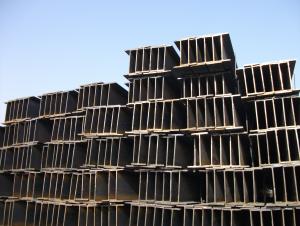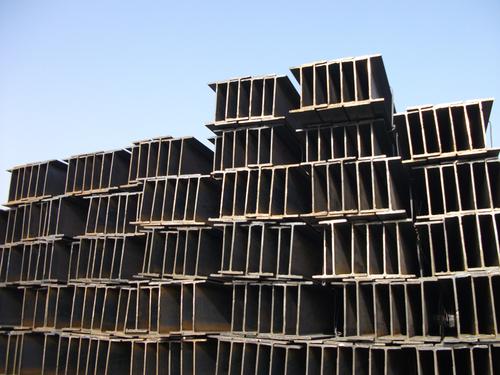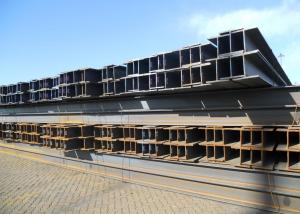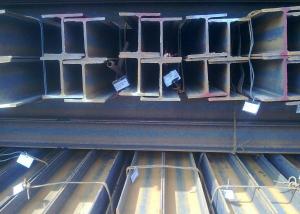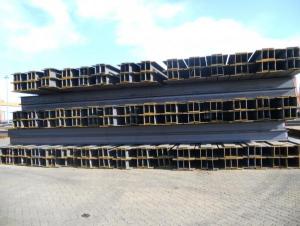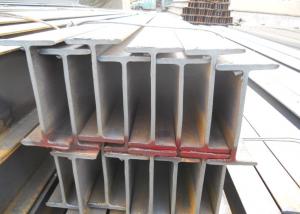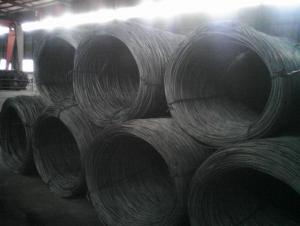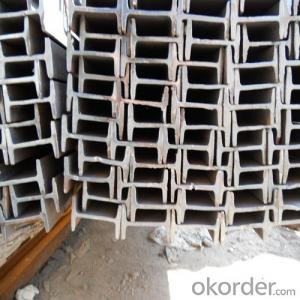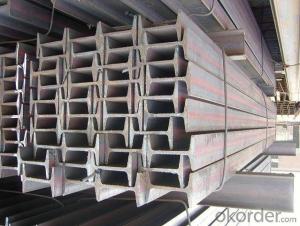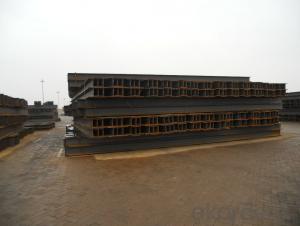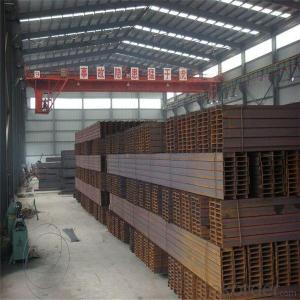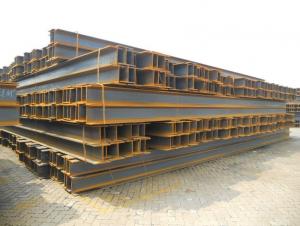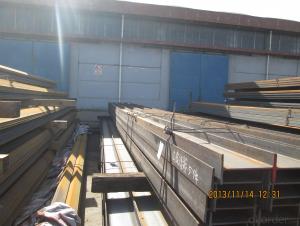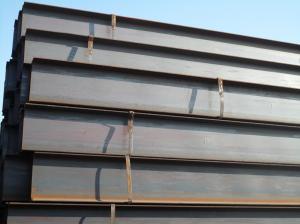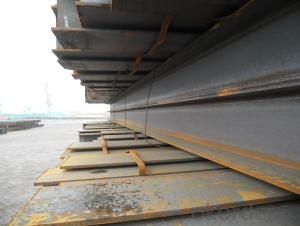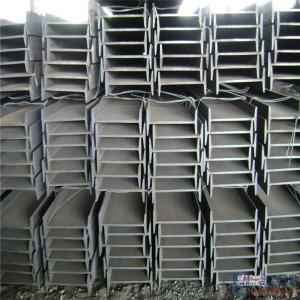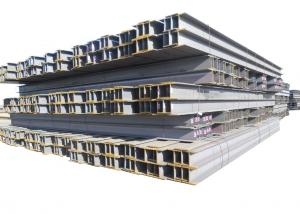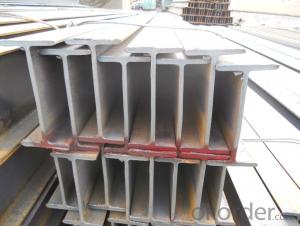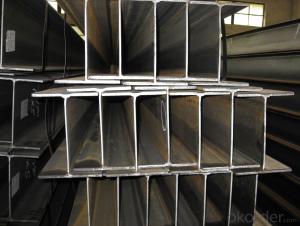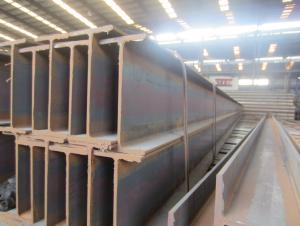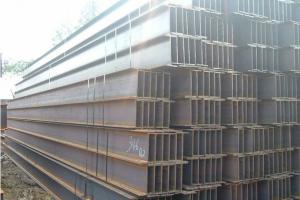JIS H Beams
- Loading Port:
- China Main Port
- Payment Terms:
- TT OR LC
- Min Order Qty:
- -
- Supply Capability:
- -
OKorder Service Pledge
OKorder Financial Service
You Might Also Like
Structural Steel H Beam Details:
| Minimum Order Quantity: | 100MT | Unit: | m.t. | Loading Port: | China Main Port |
| Supply Ability: | 10000MT | Payment Terms: | TT or LC |
Product Description:
Specifications of Hot Rolled Structural Steel H Beam
1. Standard: GB700-88, Q235B2.
2. Grade: Q235, SS400 or Equivalent
3. Length: 6m,10m, 12m as following table
4. Invoicing on theoretical weight or actual weight as customer request
5.Payment: TT or L/C
6. Sizes:
SIZE(mm) | DIMENSION(kg/m) |
100*100 | 16.9 |
125*125 | 23.6 |
150*75 | 14 |
150*150 | 31.1 |
148*100 | 20.7 |
198*99 | 17.8 |
200*100 | 20.9 |
248*124 | 25.1 |
250*125 | 29 |
Usage & Applications of Hot Rolled Structural Steel H Beam
Commercial building structure ;Pre-engineered buildings; Machinery support structure; Prefabricated structure; Medium scale bridges; Ship-building structure. etc.
Packaging & Delivery of Hot Rolled Structural Steel H Beam
1. Packing: it is nude packed in bundles by steel wire rod
2. Bundle weight: not more than 3.5MT for bulk vessel; less than 3 MT for container load
3. Marks:
Color marking: There will be color marking on both end of the bundle for the cargo delivered by bulk vessel. That makes it easily to distinguish at the destination port.
Tag mark: there will be tag mark tied up on the bundles. The information usually including supplier logo and name, product name, made in China, shipping marks and other information request by the customer.
If loading by container the marking is not needed, but we will prepare it as customer request.
4. Transportation: the goods are delivered by truck from mill to loading port, the maximum quantity can be loaded is around 40MTs by each truck. If the order quantity cannot reach the full truck loaded, the transportation cost per ton will be little higher than full load.
5. Delivered by container or bulk vessel
Production flow of Hot Rolled Structural Steel H Beam
Material prepare (billet) —heat up—rough rolling—precision rolling—cooling—packing—storage and transportation
- Q: Can steel H-beams be used for educational buildings?
- Yes, steel H-beams can be used for educational buildings. Steel H-beams are commonly used in construction due to their strength, durability, and load-bearing capabilities. They provide structural support and can be used to create large open spaces, making them suitable for educational buildings such as schools, colleges, or universities. Additionally, steel H-beams are fire-resistant and have high seismic resistance, making them a safe and reliable choice for educational structures.
- Q: What are the different joining techniques used for connecting steel H-beams?
- Some of the different joining techniques used for connecting steel H-beams include welding, bolting, and using adhesive bonding agents. Welding involves melting and fusing the steel beams together using heat, while bolting involves using bolts and nuts to fasten the beams together. Adhesive bonding agents, on the other hand, use specialized adhesives to bond the surfaces of the beams together. Each technique has its advantages and considerations depending on the specific application and requirements.
- Q: What are the different grades of steel used for H-beams?
- The different grades of steel commonly used for H-beams include A36, A572, and A992.
- Q: What are the factors that affect the cost of steel H-beams?
- There are several factors that can affect the cost of steel H-beams: 1. Raw material costs: The cost of the raw materials used to manufacture steel H-beams, such as iron ore and coal, can have a significant impact on the overall cost. Fluctuations in the prices of these materials, influenced by factors like supply and demand, can directly affect the cost of producing steel H-beams. 2. Manufacturing process: The method used to manufacture steel H-beams can also impact their cost. Different manufacturing processes, such as hot-rolling or cold-forming, require varying levels of energy, labor, and equipment, which can affect the overall cost. 3. Size and weight: The size and weight of the steel H-beams can impact the cost. Larger and heavier beams require more raw material and may require additional handling and transportation costs, which can increase the overall price. 4. Market demand: The demand for steel H-beams can also affect their cost. If there is a high demand for these beams, prices may increase due to limited supply. Conversely, if the demand is low, prices may be lower as manufacturers compete for customers. 5. Trade policies and international market conditions: Trade policies and international market conditions can also impact the cost of steel H-beams. Factors such as tariffs, import restrictions, and currency exchange rates can affect the cost of raw materials and the overall cost of production, which in turn can impact the final price of the beams. 6. Manufacturing location: The geographical location of the manufacturing facility can also play a role in the cost of steel H-beams. Different regions may have varying labor costs, energy costs, and transportation costs, all of which can affect the final price of the beams. 7. Quality and specifications: The quality and specifications of the steel H-beams can also influence their cost. Higher quality beams that meet stricter standards and specifications may command a higher price compared to lower quality beams. Overall, the cost of steel H-beams is influenced by various factors, including raw material costs, manufacturing process, size and weight, market demand, trade policies, manufacturing location, and quality and specifications. Understanding these factors can help buyers and sellers make informed decisions and negotiate prices effectively.
- Q: How are steel H-beams transported and stored?
- Steel H-beams, which are widely used in the construction industry for their strength and durability, are transported and stored in a specific manner to ensure their safety and ease of handling. During transportation, steel H-beams are typically loaded onto flatbed trucks or trailers. They are secured using chains or straps to prevent movement or shifting during transit. It is important to distribute the weight evenly and ensure that the beams are properly balanced on the truck to prevent any accidents or damage to the beams. When it comes to storage, steel H-beams are usually stored horizontally in designated areas, such as warehouses or construction sites. They are often stacked on steel racks or placed on the ground, ensuring that they are not in contact with the ground to avoid any corrosion. To protect the H-beams from environmental factors like rain, snow, or excessive sunlight, they are often covered with a tarp or stored indoors. This helps prevent rust and deterioration that can affect the integrity of the beams. Additionally, careful consideration is given to the storage layout to ensure accessibility and ease of retrieval. H-beams are typically organized based on their size and weight, with proper labeling or identification to facilitate easy identification and retrieval when needed. Proper handling and storage of steel H-beams are crucial to maintain their structural integrity and prevent any damage that may affect their performance in construction projects. Following these guidelines ensures that the beams are transported and stored safely, allowing for efficient construction processes and long-lasting structures.
- Q: What are the different design codes for steel H-beams?
- Structural engineering utilizes diverse design codes to regulate the utilization of steel H-beams. Notable design codes for steel H-beams encompass: 1. American Institute of Steel Construction (AISC) - AISC furnishes design guidelines and specifications tailored to steel H-beams in the United States. The primary design code employed for steel H-beams in the US is the AISC 360 "Specification for Structural Steel Buildings." It encompasses various elements such as design principles, load combinations, structural detailing, and material properties. 2. Eurocode - Eurocode constitutes a compilation of European standards for structural design. Eurocode 3, otherwise known as EN 1993, delivers design rules for steel structures, including H-beams. It covers domains like material properties, cross-section classification, member design, and fire resistance. 3. British Standards (BS) - The British Standards Institution (BSI) has fashioned numerous design codes for steel H-beams, such as BS 5950-1 for the structural use of steelwork in buildings and BS EN 1993-1-1 for general structural design. 4. Canadian Standards Association (CSA) - In Canada, the primary design code employed for steel H-beams is CSA S16. This code imparts design principles, material specifications, and construction requisites for steel structures. 5. Australian Standards (AS) - AS 4100 governs the design of steel H-beams in Australia. It provides guidelines for structural design using steel. 6. International Building Code (IBC) - The IBC represents a prominently adopted building code within the United States. It references several design codes, including AISC 360, for the design of steel structures, encompassing H-beams. These aforementioned instances represent a fraction of the international design codes employed for steel H-beams. It is imperative for engineers and designers to adhere to the applicable code pertinent to their region or project to ensure the secure and efficient design of steel H-beams.
- Q: Are steel H-beams suitable for long-span structures?
- Yes, steel H-beams are suitable for long-span structures. They are known for their high strength-to-weight ratio, which allows them to support heavy loads over large distances without excessive deflection. Their structural integrity and versatility make them a popular choice for various long-span applications such as bridges, industrial buildings, and large roof structures.
- Q: What are the different corrosion protection methods for steel H-beams?
- There are several corrosion protection methods available for steel H-beams to ensure their durability and longevity. 1. Coating: One of the most common methods is applying a protective coating to the H-beams. This can be done by using paints, epoxy coatings, or galvanizing. Paints and epoxy coatings create a barrier between the steel and the environment, preventing corrosion. Galvanizing involves coating the steel with a layer of zinc, which provides excellent corrosion resistance. 2. Cathodic Protection: This method involves using a sacrificial anode, typically made of zinc or aluminum, that is electrically connected to the steel H-beams. The anode corrodes instead of the steel, protecting it from corrosion. Cathodic protection is particularly useful in environments where the steel is exposed to corrosive elements such as saltwater. 3. VCI (Volatile Corrosion Inhibitor): VCI is a method in which volatile corrosion inhibitors are applied to the steel H-beams. These inhibitors release vapors that form a protective layer on the surface of the steel, inhibiting corrosion. VCI is particularly effective in environments where the H-beams may be exposed to moisture or humid conditions. 4. Passivation: Passivation involves treating the steel H-beams with an acid solution to remove any impurities or contaminants from the surface. This process creates a passive oxide layer on the steel, which provides protection against corrosion. Passivation is commonly used in conjunction with other corrosion protection methods to enhance their effectiveness. 5. Maintenance and Inspection: Regular maintenance and inspection of the steel H-beams are essential to identify any signs of corrosion early on. This includes cleaning the surface, repairing any damaged coatings, and replacing corroded sections if necessary. By properly maintaining the H-beams, the risk of corrosion can be minimized, ensuring their long-term protection. It is important to choose the appropriate corrosion protection method based on the specific environmental conditions and requirements of the steel H-beams. Consulting with corrosion protection experts or engineers can help in determining the most suitable method for a particular application.
- Q: How do steel H-beams perform in oil and gas industry applications?
- Due to their exceptional performance characteristics, steel H-beams are widely utilized in the oil and gas industry. These beams have demonstrated remarkable reliability and effectiveness in diverse applications within the industry. One primary advantage of steel H-beams lies in their strength and durability. They are engineered to endure heavy loads and provide structural support, rendering them ideal for implementation in oil and gas platforms, pipelines, and storage tanks. Steel H-beams possess high tensile strength, enabling them to resist bending and deformation even under extreme conditions. Apart from their strength, steel H-beams also exhibit excellent resistance to corrosion. Given that the oil and gas industry operates in harsh environments that subject equipment and structures to corrosive elements like water, salt, and chemicals, steel H-beams are frequently coated with protective layers or constructed using corrosion-resistant alloys to ensure long-term performance and prevent deterioration. Another noteworthy characteristic of steel H-beams is their versatility. They can be easily fabricated and customized to meet specific project requirements, including length, width, and load-bearing capacity. This adaptability makes them suitable for a wide range of oil and gas applications, from offshore platforms to onshore processing plants. Furthermore, steel H-beams are recognized for their cost-effectiveness. They offer a high ratio of strength to weight, meaning they can support heavy loads while minimizing the amount of material used. This not only reduces construction costs but also facilitates more efficient transportation and installation. Overall, steel H-beams have established themselves as highly reliable and efficient in oil and gas industry applications. Their strength, corrosion resistance, versatility, and cost-effectiveness position them as the preferred choice for various structural and support systems, thereby contributing to the overall safety and efficiency of operations in the industry.
- Q: What are the acoustic properties of steel H-beams?
- Steel H-beams have excellent acoustic properties due to their high density and stiffness. They effectively dampen sound vibrations and reduce noise transmission, making them ideal for applications requiring sound insulation and structural stability.
Send your message to us
JIS H Beams
- Loading Port:
- China Main Port
- Payment Terms:
- TT OR LC
- Min Order Qty:
- -
- Supply Capability:
- -
OKorder Service Pledge
OKorder Financial Service
Similar products
Hot products
Hot Searches
Related keywords
